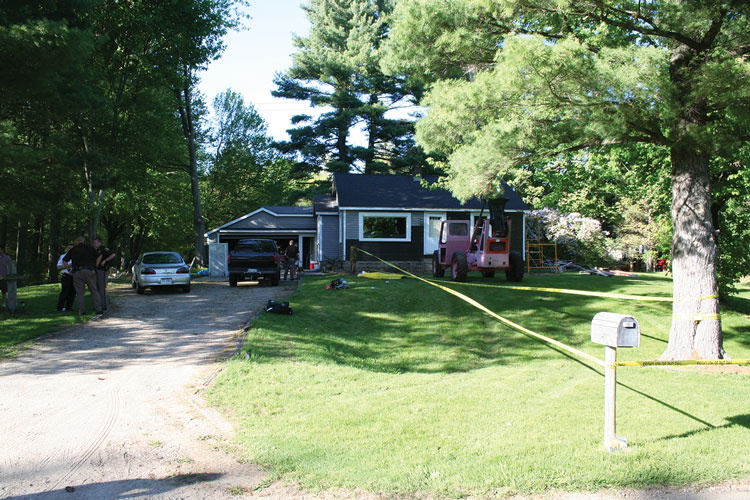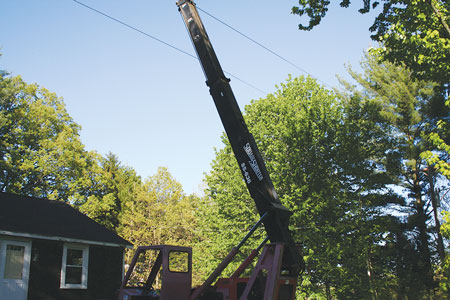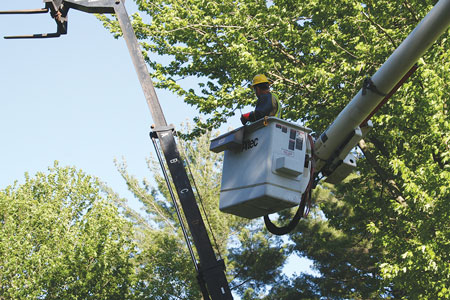
BY GARY M. DREYER
On May 18, 2015, while preparing for a regular training session and a new recruit orientation scheduled for 1900 hours, the Crockery Township (MI) Fire Department (CTFD) was dispatched to one of the most difficult incidents it has ever faced. At 1750 hours, the Ottawa County (MI) Central Dispatch Authority (OCCDA) received a 911 call from a woman who had found her husband lying in the yard next to a telescoping forklift that was still running. The caller did not know how long he had been down; when asked if he was cold to the touch, she said his arms were still warm. At this point, the OCCDA dispatcher changed the call status from a death to an active medical call and began prompting the caller in performing cardiopulmonary resuscitation (CPR) on the patient and dispatched fire and emergency medical service (EMS) units (photo 1).
1751 hours. The CTFD was dispatched to a medical emergency at 11845 Apple Drive (half a mile away from the station) involving a 43-year-old male who was not breathing; the patient’s wife was already performing Class 1 CPR for cardiac arrest at 1751 hours. Deputy Chief John Kriger responded to the scene directly in his personal vehicle and arrived on scene at 1754 hours with Firefighter Jason Defouw. On arrival, Kriger saw the patient’s wife performing CPR in the front yard of the residence. He approached the patient with his medical equipment and an automatic external defibrillator (AED) and set up to begin working on the patient and assume incident command.
Responder Becomes Patient
1755 hours. On arrival with Firefighter Jason Tiemeyer, I brought the squad’s medical gear and an AED to the scene as Kriger was turning off the lift’s ignition. He remained as incident commander (IC). Defouw was setting up airway equipment, I was setting up the AED, and Kriger then took over doing chest compressions from the patient’s wife. During this process, Tiemeyer was repositioning to assist with compressions when his hip came too close to the front hub of the lift and personnel on scene heard the distinct sound of an electrical arc. Kriger immediately shouted a warning to Tiemeyer just as he fell forward onto Kriger (who felt the electric current pass through him) and the patient. Although Kriger felt chest pains as a result, he continued performing CPR on the patient.
1756 hours. Kriger advised dispatch, “We have an electrocution [electric shock] on Apple Drive” and requested the power company to respond. Immediately following this transmission, to clarify the situation, I radioed in, “Requesting a second ambulance; one responder down.” As this was occurring, Firefighter Erik Erhorn arrived on scene; with Defouw, he moved Tiemeyer to a safe location to begin treatment approximately six to eight feet away from the machine. Over the next minute, additional police units monitoring the fire frequency began self-dispatching. At this point, Tiemeyer had been seizing for about 1½ minutes, and his face and neck were turning dark purple. At 1758 hours, I requested a mutual-aid squad from the Spring Lake Township Fire Department to respond, while Kriger also requested all personnel staffing the CTFD station to respond to the scene. When dispatching mutual-aid companies, the dispatcher relayed, “Assist to Crockery-1845 Apple Drive-two subjects down-units responding-use caution-subjects have been electrocuted [received electric shocks].”
1759 hours. Tiemeyer lost his pulse, and his breathing stopped. At this point, Kriger notified dispatch that there were “Two subjects, Class 1, with a boom of machine into a power line.” After this transmission, several additional police units self-dispatched. The first police unit arrived on scene at 1801, and the officer said that he was next to the machine and that the boom was not touching the power lines. At this point, the OCCDA was still in contact with the local power company. Finally, 30 seconds later, the same police unit advised that the machine boom was touching the power line and started setting up a perimeter around the power lines. The first mutual-aid squad was en route at 1802 hours, and four additional personnel arrived on scene.
![(1) The response scene postincident. The patient was to the left of the telescoping forklift, receiving CPR from his wife. The trees obscure the view of overhead wires. [Photos by the Ottawa County (MI) Sheriff’s Department.]](https://emberly.fireengineering.com/wp-content/uploads/2016/12/1612FE_DreyerPhoto1.jpg) |
| (1) The response scene postincident. The patient was to the left of the telescoping forklift, receiving CPR from his wife. The trees obscure the view of overhead wires. [Photos by the Ottawa County (MI) Sheriff’s Department.] |
1804 hours. Kriger advised dispatch that there was a pulse on the second Class 1 CPR patient (Tiemeyer). Personnel were still performing CPR on the original patient. The OCCDA said it had no estimated time of arrival for the power company and that CTFD Engine 521 was responding. The first ambulance arrived on scene at 1805 hours; at 1807 hours, the Grand Haven Township fire paramedic unit self-dispatched with a CPR machine. The second ambulance arrived on scene and was en route to the hospital with Tiemeyer by 1814 hours. By 1821 hours, despite extended administration of CPR and implementation of advanced life support (ALS) protocols, the initial victim did not respond, and the medical examiner was called.
1825 hours. Kriger advised Lieutenant Mike Killebrew that he had received an electrical shock and was experiencing chest pains; he was relieved of command and was transferred to the ALS crew for treatment. At this time, the Grand Haven Charter Township Fire & Rescue moved into CTFD’s station to cover its response area, supplemented at 1842 hours with an engine and rescue from Spring Lake Fire Department to handle all calls for the evening.
1828 hours. The power company arrived. By 1900 hours, the regional critical incident stress debriefing team was requested to respond to the CTFD station for an immediate defusing of the incident with all personnel who had been on scene.
Kriger was transported, evaluated for electric shock, and released from the hospital by 2200 hours. He immediately went to visit Tiemeyer, who was treated and kept for two nights at the hospital. He was released for light duty 14 days later and returned to full duty within 21 days of the incident. He suffered some minor lasting effects, such as occasional hip pain.
Lessons Learned
During after-action reviews, all personnel recalled noting that the lift boom was in a “nonworking” position-fully raised and extended over the top of the single-story residence. Kriger and I recalled that when we approached the scene while bystander CPR was in progress, we each looked up at the boom to determine whether it was in contact with the wires. But the heavy tree cover obscured the view of lines from the angle of approach. Even after the electrical arcing confirmed that the equipment was touching the wire, visually it appeared as though there was a gap of at least six to eight inches between the wires and the boom from any angle except when viewing from the side (photo 2). This was because the chain that controlled the lift boom was offset from the back of the boom by several inches (photo 3).
Because the chain and the boom were painted black and covered in grease, even after wire contact was confirmed, other responders said that after looking carefully, it appeared that the wires were not in contact with the equipment, until they viewed the machine from the side.
Size-up. At times, a rapid scene size-up may not be enough; do a thorough reassessment as soon as possible. Although three personnel performed a scene overview and assessment as they approached, all three missed the danger hidden overhead. Any time construction equipment is present at an emergency, energized electrical equipment is a possibility.
In reviewing the dispatch recordings afterward, it sounded as if the wife might have received an electrical shock when attempting to shut off the forklift. Tiemeyer was wearing ordinary sneakers, whereas other responders on scene wore heavy work shoes.
AEDs. When upgrading its AEDs, the department kept the older AEDs to equip officers and firefighters rather than trade them in for $250 each, more than the cost of one new AED. The CTFD developed a standard operating procedure that all personnel carrying medical equipment and AEDs should bring them to the scene. Having a second AED allowed immediate access to the device instead of waiting for an additional apparatus.
 |
| (2) The view opposite the angle of approach. Although it appears that the boom is running between the two wires, the bottom wire runs over and is in contact with the boom, although it seems to run behind it. |
Training. When the electrical arc involving Tiemeyer occurred, the four personnel closest on scene responded without any verbal commands to move him and provide initial care. They said they based their coordination on their physical positions.
Communications. On scene, Kriger and I communicated this incident to the dispatch center, although we did not use the word “Mayday.” We supplemented each other’s reports with additional information as needed. For example, I communicated the on-scene needs to off-scene personnel when I realized they were unaware of them. According to the national incident management system, only the IC should communicate with the dispatch center. Because we joined the mutual aid box alarm system (MABAS), the department had an up-to-date emergency contact and health information for personnel to relay to care providers and investigators.
Interagency cooperation. A positive relationship with law enforcement enhanced our response. The law enforcement responders included a Michigan State Police officer who “self-dispatched” on learning it was a firefighter-down incident. Their tremendous support included aiding in CPR, providing scene security, conducting a third-party investigation, notifying the victims’ families, and offering to transport family members to the hospital.
Media. For the first 18 hours after the incident, law enforcement handled media releases, after which the fire department held a controlled press conference at which the firefighters’ names and the incident’s specifics were withheld. This allowed the department some space to return to normal. If an off-limits question was asked, the response was that an investigation was ongoing, and the department declined to speculate-e.g., “What if a second AED had not been available?”
Critical incident stress debriefing. Once the scene was stabilized, we requested the Midwest Michigan Critical Incident Stress Management Team to respond. The department canceled the new firefighters’ orientation and sent them home. During the four-hour diffusing and debriefing, mutual-aid units covered the district for the period. The down firefighters’ condition was continually updated during this session. A formal debriefing was scheduled after Tiemeyer was out of the hospital and able to attend. The session included dispatch, mutual aid, EMS, and law enforcement personnel. Including all responder disciplines involved aided in their recovery and healing.
 |
| (3) A power lineman holds the deenergized wire away from the boom chain. The gap between the boom and the chain confused observers as to whether the wire was in contact. |
Mayday. In a Mayday, on-scene personnel must listen to all radio traffic. Transmit any additional critical information missed initially. In this event, Kriger did not clearly communicate that a second patient who was a responder had suffered electrical shock and did not use the word Mayday. A follow-up report immediately communicated the situation and resources needed.
Although intended for use in a firefighter Mayday in a structure, the location, unit, nature of emergency, assessment, resources (LUNAR) report can be adapted to any response situation, such as the initial radio report on arrival as follows: L-Apple Drive; U-Apple command; N-We have an electrical shock; A-One responder down; R- Additional squad and ambulance personnel response. Within minutes, this would be updated with “Two Class 1s” (cardiac arrests) and the identification of the electrical source.
Training. The CTFD performs fire and EMS scenario-based training, which allowed personnel at this incident to adapt quickly and divide the workload on scene. When moving Tiemeyer away from the initial patient, dividing the workload occurred with no verbal communication between the personnel on scene. Each two-firefighter team knew what needed to be done, and the team of four made it happen without needing direction. As additional resources arrived, they were directed to the appropriate patient.
Since this incident, when the CTFD responds to a cardiac arrest, we automatically send our second rescue squad with additional staff. Also, we have placed in service several electrical field detectors that are used on wildland, motor vehicle, and industrial incidents. Although the initial victim did not survive, the overall lessons learned were important.
GARY M. DREYER joined the fire service in 1991 and is chief of the Crockery Township (MI) Fire Department. He has served as an officer with other combination departments for more than 20 years. He is certified as a fire officer, a fire and explosion investigator, and an emergency medical technician-basic. He has an associate degree in fire science and is working toward a bachelor’s degree in fire administration at Western Illinois University.
SAVING OUR OWN : APPROACHING A DOWNED FIREFIGHTER
Electrical Oddities
UNDERSTANDING ELECTRICITY AND ELECTRICAL DANGERS
Fire Engineering Archives

